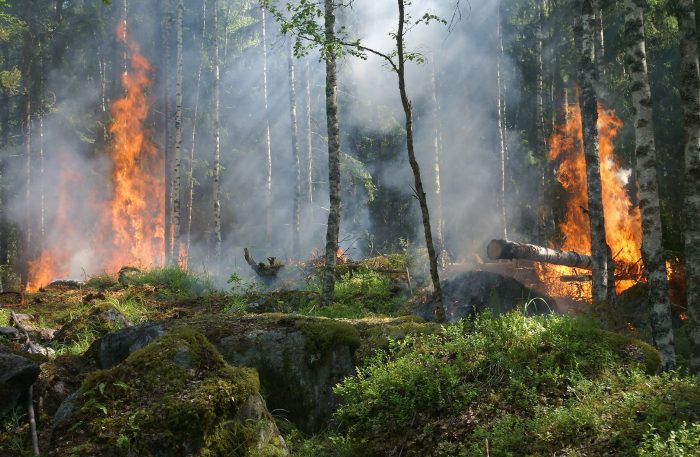Droughts fueled by climate change are causing massive wild-fires with huge direct and indirect cost which is all passed on to consumer and society through higher prices across health, consumer goods and food. The Western U.S. has been hit by drought records this summer and for the first time ever, over 95% of the region is in severe and potentially irreversible drought. Roughly 10% of the U.S. is facing an extreme drought compounded[1] by heat waves (above 100 Degrees Fahrenheit), which is leading to water shortages, energy shocks and decreased food production. This dry climate has led to record low water levels at Lake Mead and Lake Powell, the two largest reservoirs in the U.S. Lake Mead is only at 35 percent capacity, and its level has decreased about 140 feet since 2000. As I write this article, it’s water level has dropped to 1,067 feet triggering the first ever water conservation plan and cutting water supply to many Western States. This includes cut of at least 20% of the water supplied to Arizona through the Colorado River.
Just to be clear, the drought is not new to the Western US, as this region has been going through a prolonged period of water stress (over 15 years long). This is commonly referred to as a megadrought. However, according to Nasa, 2021 was exceptionally concerning, and will go down as the driest year in over 500 years. Other research such as the US Drought Monitor, suggest this year water stress could be the harshest in 1200 years.
While climate change is not the only cause of the drought, global warming and sustained high temperature led to excessive evaporation in the already water stressed western US. Throughout the last decade drought and climate change has compounded other hazard risk resulting in more severe and frequent disaster events such as wild-fire, costing the US economy billions of dollars in direct and indirect cost. In 2021, there have been over 41,768 wildfires across the country burning more than 4.8 million acres. In 2020 alone, according to AccuWeather, the total cost due to wildfire in the US amounted to US$ 150 billion.
[1] A compound extreme disaster event is when more than one extreme happens at the same time
Droughts Challenges and Opportunities: Drought is a slow-moving natural hazard (a creeping phenomenon), which destroys livelihood and economies, but the effects of which often accumulate slowly over a long period of time. As its impacts are measured over a longer time-period, it is harder to manage, and to mitigate, as most people, particularly policy makers have a short-term agendas and drought are perceived as low probability events.
Furthermore, drought do not cause structural damage, as hurricane, floods and forest fire do. For these reasons, the quantification of impacts and the development of drought risk management plans are much more complex for drought than they are for other natural hazards. These characteristics of drought have hindered the development of systematic, reliable, and yearly estimates of costing and impacts and, ultimately, the formulation of drought risk management plans by most governments. A proactive approach to change this, and improve drought resilience immediately includes at least the following “low regret actions” a) establish drought monitoring and early warning systems; b) perform vulnerability and risk assessment (done every year estimating probable cost of not acting); and c) create drought risk mitigation measures.
Drought and Fire Cost: Droughts are among the most-costly climate-related hazards and they are also the most difficult to measure and mitigate. According to national authorities, annual average losses of about $9 billion per year (this cost is in my opinion extremely low as it does not capture indirect cost), drought is a serious hazard with substantial socioeconomic risks for the United States. Between 1980 and 2020, drought cost nearly $250 billion in damages and killed nearly 3,000 people, making it the most expensive and second-most deadly natural disaster in the U.S.
As we look at the projected cost of droughts in a more extensive way, we can refer to some reputable quantitative studies, which includes the “Stern Review on The Economics of Climate Change, 2006” which estimated climate cost in 2025, and 2100. I find fascinating that these reports projections (which are 15 years old and were highly criticized) are now being validated by new climate modelling exercises.
To be more specific to the water/drought cost, the “global warming price tag” in the water sector alone (since we are looking at the cost of hydric stress and drought) would be one of the hardest felt. By 2025, managing water stress in the US, will cost about US$ 200 billion (1.36 per cent of GDP). By 2100, addressing water needs in the US will cost an estimated $950 billion more per year as a result of climate change. Keep in mind that this is the estimated cost of the water sector alone, and if we compound other hazard events (wild-fire, surge storms and hurricane), the total annual GDP that could be lost by 2100 amounts to 3.6 per cent.
Final Thoughts: Policy makers will be slow to act on drought as the damage and losses are not as tangible as with other climate disaster and in spite of the massive fires and heatwave seen this summer. Drought is our new normal and we have to adapt to a more shock prone environment driven by scarce water, more intense and frequent compound climate disasters and higher societal cost of adaptation.
In order to become more resilient, bold actions are required, and decision makers should take risk focused on technology driven prevention investment across cross-cutting segment of People, Markets & Institutions. My message to all is, lets capitalize on this crisis pivotal moments (including Covid and Climate), and build smarter risk management systems to catalyze change and to capitalize on the climate opportunity. The most affected regions should lead the way and develop systematic and simple assessments of the cost of not acting now. This will help show Americans, that one dollar spent on prevention will save up to ten dollars in recovery and emergency management costs (Fema, World Bank, and UNISDR). Let’s be smart reduce losses and invest in a more resilient and “risk proofed” United States.









Read 1 comment and reply